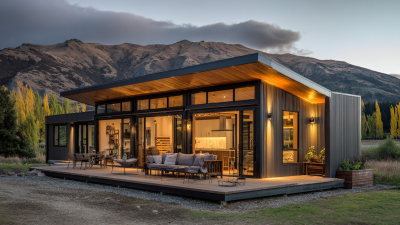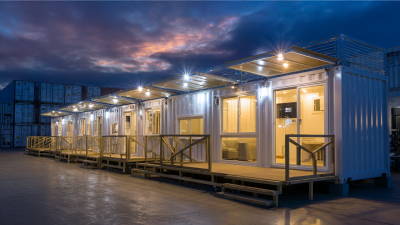In recent years, the construction industry has witnessed a significant shift towards sustainable living solutions, with prefabricated houses emerging as a leading solution. According to a 2022 report by the World Green Building Council, prefabricated houses can reduce material waste by up to 70% compared to traditional building methods, making them an environmentally friendly alternative. Furthermore, the Global Prefabricated Housing Market is projected to grow from USD 112.82 billion in 2020 to USD 207.12 billion by 2027, reflecting a growing demand for efficient and sustainable housing. This trend is not only reshaping the architectural landscape but also responding to the urgent need for housing solutions that prioritize sustainability. As we explore the future of sustainable living, innovative prefabricated houses stand at the forefront, offering a blend of efficiency, sustainability, and modern design that aligns with contemporary environmental goals.

Prefabricated houses, with their efficient construction processes and sustainable materials, play a pivotal role in the quest for net zero emissions by 2030. These homes are built off-site using modules that are fabricated in controlled environments, which not only reduces waste but also minimizes energy consumption during the building process. By leveraging technology, such as advanced insulation materials and energy-efficient systems, prefabricated houses are designed to consume significantly less energy over their lifetime, contributing to overall emissions reduction.
Moreover, the adaptability of prefabricated houses allows for sustainable living to be accessible to a wider audience. As urban populations continue to grow, the demand for affordable housing solutions is escalating. Prefabricated homes can be rapidly deployed in various environments, from urban to rural settings, while utilizing local materials and resources. This flexibility not only reduces the carbon footprint associated with transportation but also promotes community resilience and sustainability. By embracing innovative prefabrication methods, we can take significant strides toward achieving net zero emissions and fostering a greener future.
| Feature | Value |
|---|---|
| Construction Time | 30% faster than traditional building |
| Energy Efficiency | Up to 50% more efficient |
| Materials Used | Sustainable and recycled materials |
| Lifetime Carbon Emissions | Reduced by up to 70% |
| Average Cost | $150,000 - $300,000 |
| Water Usage | 30% less than conventional homes |
| Recyclability | Over 90% recyclable at end of lifespan |
The growing trend in sustainable architecture is significantly influenced by innovative materials that enhance energy efficiency in prefabricated houses. As the global demand for sustainable building solutions surges, the prefabricated construction market is poised for remarkable growth, with projections indicating an increase from $181.63 billion in 2025 to $254.71 billion by 2034. This upward trajectory is driven by the need for efficient, high-quality building processes that minimize environmental impact while maximizing resource utility.
One notable advancement in this sector is the integration of lightweight aggregate concrete, expected to grow significantly, with a market size anticipated to reach $83.86 billion by 2033. Additionally, the rising popularity of building-integrated photovoltaics (BIPV) signifies a shift towards energy-generating structures, potentially growing from $23.41 billion in 2025 to $74.43 billion by 2032. These innovative materials are not only cost-effective but also contribute to achieving nearly zero energy consumption in new constructions, ensuring that future developments align with the principles of sustainable living.
The cost-effectiveness of prefabricated homes is increasingly clear as more homeowners and developers shift towards sustainable living. These innovative houses not only offer long-term savings on construction costs but also significantly reduce energy consumption over their lifespan. By utilizing advanced energy-efficient materials and methodologies, prefabricated homes play a crucial role in minimizing greenhouse gas emissions, particularly in countries like Canada, where buildings account for a substantial portion of emissions.
Tips: Consider incorporating energy-efficient upgrades during the prefabricated home assembly process. Implementing solar panels or energy-efficient HVAC systems can further enhance savings and reduce the environmental footprint.
Moreover, the efficiency of prefabricated construction methods allows for quicker build times, which not only accelerates occupancy but also reduces labor costs. Analyzing cost impacts from design to installation reveals that these homes can deliver remarkable value, enhancing both economic and environmental benefits. As interest in sustainable housing continues to rise, prefabricated homes are a viable solution for those looking to invest in the future of eco-friendly living.
Tips: Research local incentives for energy-efficient homes that can further offset initial costs. Many governments offer tax breaks or financial aid for sustainable construction practices.

As urbanization continues to accelerate, particularly in developing regions, the demand for sustainable and affordable housing solutions has become critical. With over 60% of urban dwellers in Africa living in informal settlements, innovative approaches, such as prefabricated construction, offer scalable solutions to address the housing crisis. The global modular construction market is projected to grow from USD 113.07 billion in 2024 to USD 173.53 billion by 2033, representing a compound annual growth rate (CAGR) of 5.5%. This growth reflects the rising demand for sustainable materials and smart design principles that enhance construction efficiency and reduce environmental impact.

In regions like Northeast India, the focus on material innovations is essential for enhancing the affordability and sustainability of traditional housing, such as the Assam-type houses. By leveraging advancements in materials, builders can create structures that are not only cost-effective but also durable and environmentally friendly. Meanwhile, the global prefabricated building system market is anticipated to reach USD 22.64 billion by 2035, primarily driven by sustainability initiatives and technological innovations that streamline construction processes and reduce waste. This evolution in construction technology aligns with the broader need for sustainable urban living solutions in rapidly growing cities worldwide.
The demand for prefabricated eco-friendly homes is witnessing a notable surge as more consumers become conscious of their environmental footprint. This trend reflects a broader societal shift towards sustainable living, where individuals seek innovative housing solutions that not only minimize ecological impact but also offer efficiency and affordability. Prefabricated homes, crafted from sustainable materials, can reduce construction waste and shorten build times, making them an attractive option for modern homeowners.
**Tips for Choosing Sustainable Prefabricated Homes:**
- Consider the materials used in construction. Look for homes built with recycled or sustainably sourced materials to ensure minimal environmental impact.
- Evaluate energy efficiency features, such as insulation and renewable energy options, which contribute to lower utility bills and a reduced carbon footprint.
- Research the builder's reputation and experience with eco-friendly construction to ensure high-quality and sustainable designs.
With an increasing number of manufacturers offering customizable options, homeowners can create spaces that align with their values, making sustainable living not just a trend, but a practical lifestyle choice. This evolution in consumer preferences emphasizes the importance of responsible home-building practices that cater to the needs of both the environment and the individual.
As the demand for eco-friendly homes rises, the following data illustrates consumer interest in various sustainable housing options over the past five years.






